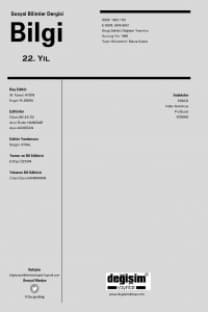Döviz Kuru ve Petrol Fiyatının BİST Sınai Endeksi Üzerine Etkisi: Eşbütünleşme ve Nedensellik Analizi
The Effect of Exchange Rate and Oil Price on BIST Industrial Index: Cointegration and Causality Analysis
Oil Price, Exchange Rate, Causality Co-integration,
___
- Agazade, Ş. (2020). Oil Prices and Kazakhstan Real Exchange Rate: Petrol Fiyatları ve Kazakistan Reel Döviz Kuru: ARDL Sınır Testi Yaklaşımı [ARDL Boundary Test Approach]. Bilig - Bilig – Türk Dünyası Sosyal Bilimler Dergisi, 94, 217-248. Baimaganbetov, S., Zhetibayev, Z., Alimkulova, E., & Makhanbetova, U. (2019). Oil Prices and Exchange Rate Relationship: Panel Data Analysis for Selected Oil Exporter Countries. Bulletin of Economic Theory and Analysis, 4(1), 1-11.
- Bal, D. P., & Rath, B. N. (2015). Nonlinear Causality Between Crude Oil Price and Exchange Rate: A comparative study of China and India. Energy Economics,51, 149-156.
- Bayramoglu, M. F. & Tay Bayramoglu, A. & Ergün M. A. (2019), Döviz Kuru ve Petrol Fiyatları Arasındaki İlişkinin Ortalamada ve Varyansta Nedensellik Testi ile Analizi [Analysis of the Relationship Between Exchange Rate and Oil Prices by Causality Test in Mean and Variance], BMIJ, 7(5):2112-2123.
- Bhattacharya, S. N., Jha, S. K., & Bhattacharya, M. (2019). Dependence Between Oil Price and Exchange Rate Volatility: An Empirical Analysis. Journal of Applied Economics & Business Research, 9(1),15-26.
- Cıtak, F., & Kendirli, S. (2019). Petrol Fiyatlarının Döviz Kuru ve Hisse Senedi Getirileri Üzerindeki Asimetrik Etkisi: Türkiye Örneği [Oil Prices Currency and Stock Returns Asymmetric Effect on: The Case of Turkey]. Finans Ekonomi ve Sosyal Araştırmalar Dergisi (FESA), 4(4), 643-658.
- Dalgıc, A. Türkiye’de Sanayileşme Süreci ve Sanayileşmenin Geleceği [Industrialization Process and the Future of Industrialization in Turkey].
- Ding, H., Jin, Y., Qin, C., & Ying, J. (2020). Tail Causality between Crude Oil Price and RMB Exchange Rate. China & World Economy, 28(3), 116-134.
- Golub, S. S. (1983). Oil Prices and Exchange Rates. The Economic Journal, 93(371), 576-593.
- Gülhan Ü., (2020). Altın Fiyatları İle VIX Endeksi, BİST 100 Endeksi, Döviz Kuru ve Petrol Fiyatları İlişkisi: Ekonometrik Bir Analiz[Relationship Between Gold Prices and VIX Index, BIST 100 Index, Exchange Rate and Oil Price: An Econometric Analysis], Gümüşhane Üniversitesi Sosyal Bilimler Enstitüsü Elektronik Dergisi, 11(2), 576-591.
- Hussin, M. Y. M., Muhammad, F., Hussin, M. A., & Razak, A. A. (2012). The relationship between oil price, exchange rate and Islamic stock market in Malaysia. Research Journal of Finance and Accounting, 3(5), 83-92.
- Isık, N, Acar, M. & Isık, B. (2004). Enflasyon ve Döviz Kuru İlişkisi: Bir Eşbütünleşme Analizi [The Relationship Between Inflation and Exchange Rate: A Cointegration Analysis]. Süleyman Demirel Üniversitesi İktisadi ve İdari Bilimler Fakültesi Dergisi, 9(2), 325-340.
- Jung, Y. C., Das, A., & McFarlane, A. (2020). The Asymmetric Relationship Between The Oil Price And The US-Canada Exchange Rate. The Quarterly Review of Economics and Finance, 76, 198-206.
- Karadas, H. A., & Kosaroglu, Ş. M.(2020), Tarım Ürünleri Fiyatları, Ham Petrol Fiyatı ve Döviz Kuru İlişkisi: Türkiye İçin Eşbütünleşme Analizi [Agricultural Product Prices, Crude Oil Prices and Exchange Rate Relation: Cointegration Analysis for Turkey]. İstanbul Ticaret Üniversitesi Sosyal Bilimler Dergisi, 19, 515-526. Kutlar, A. (2017), Applied Time Series with Eviews, Umuttepe, Izmit. Krugman, P. R. (1980). Oil and the Dollar (No. w0554). National Bureau of Economic Research.1-20.
- Musa, K. S., Maijama’a,R., Muhammed, N. &Usman, A. (2020), Crude Oil Price and Exchange Rate Nexus: An Ardl Bound Approach, Open Access Library Journal, 7(3),1-24.
- Nguyen, T. N., Nguyen, D. T., & Nguyen, V. N. (2020). The impacts of oil price and exchange rate on Vietnamese stock market. Journal of Asian Finance, Economics and Business, 7(8), 143-150.
- Nurmakhanova, M., & Katenova, M. (2019). Are Stock Market and Exchange Rate Affected by Oil Price in Kazakhstan?. International Journal of Engineering Business Management, 11,1-9.
- Tarı, R. (2010), Econometrics, Umuttepe, Izmit.
- Turkish Language Association (TLA), Received Access: 21.10.2020, https://sozluk.gov.tr/
- Tiwari, A. K., & Albulescu, C. T. (2016). Oil Price and Exchange Rate in India: Fresh Evidence From Continuous Wavelet Approach and Asymmetric, Multi-Horizon Granger-Causality Tests. Applied Energy, 179, 272-283. Ugur, A, & Bıngol, N. (2020). Hisse Senedi ve Döviz Kuru İlişkisinin Yönü: Türkiye Üzerine Bir Araştırma [The Direction Of The Stock And Foreign Exchange Relations: A Research On Turkey]. Ömer Halisdemir Üniversitesi İktisadi ve İdari Bilimler Fakültesi Dergisi, 13 (4) , 624-636.
- Zolfaghari, M., & Sahabi, B. (2020). The impact of Oil Price and Exchange Rate on Momentum Strategy Profits in Stock Market: Evidence From Oil-Rich Developing Countries. Review of Managerial Science, 1-43.
- ISSN: 1302-1761
- Yayın Aralığı: Yılda 2 Sayı
- Başlangıç: 1999
- Yayıncı: Değişim Yayınları
Kerim Eser AFŞAR, Egemen C. TOKER
Milletin Mimarisi Yeni İslamcı Ulus İnşasının Kent ve Mekân Siyaseti
Çevresel Sürdürülebilirliğin Değerlendirilmesi: Dinamik Mekânsal Panel Veri Yaklaşımı
Kronik Bir Sosyal Sorun: Engellilere Yönelik Ayrımcılık
